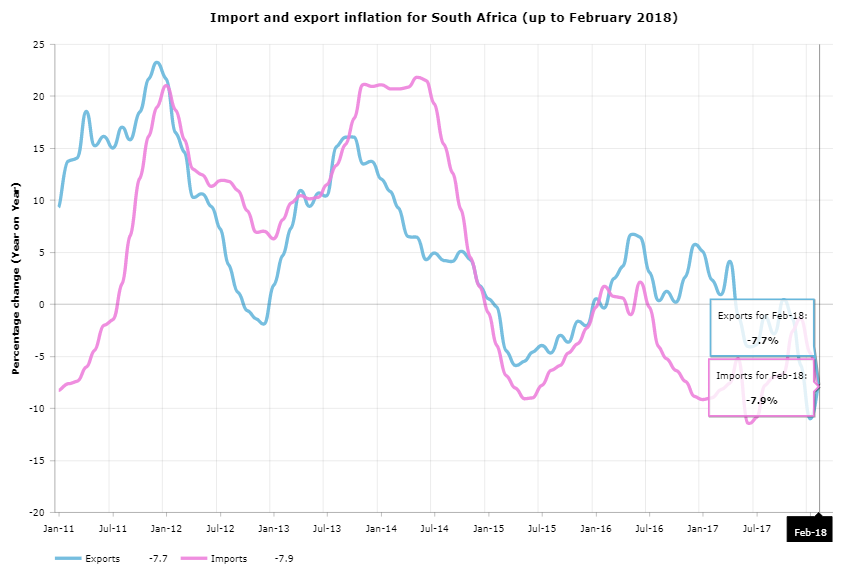|
Related Topics |
|
In today's blog we take a look at the latest import and export prices for South Africa and find that import and export inflation for South Africa has been on the decline for a while now.
While it is good for local inflation numbers when import inflation is low or negative, we suspect this trend will soon end due to rapidly depreciating exchange rate, and fast increasing oil prices (which is one of South Africa's main imports). |
Annual change in inflation for South African imports and exports
The graphic below shows the annual rate of inflation for both imports and export from January 2011 up to February 2018. And as the graphic shows South Africa has experienced extended periods of declining import prices, and this was largely linked to declining oil prices (as oil makes up over 10% of South Africa's imports).
As the line graph above indicates, import and export inflation is far off the highs it reached respectively. Export inflation reached a high towards the end of 2011 with December 2011 export inflation reaching levels of close to 24%, while import inflation reached a high of 21.8% in May 2014. Since then there has been a gradual decline in the level of price increases for both South African imports and exports.
For February 2018 import and export inflation reached the following levels:
So much so that South Africa's inflation is now well within the South African Reserve Bank (SARB)'s inflation target of between 3% and 6%. With South Africa's inflation for March 2018 sitting at 3.8% (the lowest level seen in years). And this makes one wonder why the SARB MPC did not cut interest rates by more than 25 basis points in their last meeting?
Are they worried about the weakening exchange rate and increasing oil prices in future import inflation? Or are they worried about the potential impact on prices due to the latest budget speech tax increases, such as increase in VAT from 14% to 15%, fuel levy increases, "sin taxes" being increased etc.
We personally feel SARB could have cut rates by at least 50 basis points, and believe the impact of VAT increase on consumer inflation will be minimal. We therefore predict SARB will cut rates again in this year. Perhaps not at their next meeting (which is in May) but at their July 2018 meeting.
For February 2018 import and export inflation reached the following levels:
- Imports: -7.9%
- Exports: -7.7%
So much so that South Africa's inflation is now well within the South African Reserve Bank (SARB)'s inflation target of between 3% and 6%. With South Africa's inflation for March 2018 sitting at 3.8% (the lowest level seen in years). And this makes one wonder why the SARB MPC did not cut interest rates by more than 25 basis points in their last meeting?
Are they worried about the weakening exchange rate and increasing oil prices in future import inflation? Or are they worried about the potential impact on prices due to the latest budget speech tax increases, such as increase in VAT from 14% to 15%, fuel levy increases, "sin taxes" being increased etc.
We personally feel SARB could have cut rates by at least 50 basis points, and believe the impact of VAT increase on consumer inflation will be minimal. We therefore predict SARB will cut rates again in this year. Perhaps not at their next meeting (which is in May) but at their July 2018 meeting.
Let us know what you thought of this article: |
